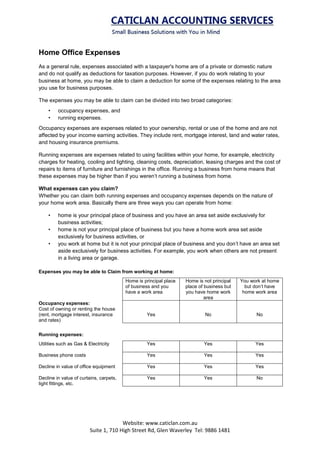Claiming home office expenses
- 1. Website: www.caticlan.com.au Suite 1, 710 High Street Rd, Glen Waverley Tel: 9886 1481 Home Office Expenses As a general rule, expenses associated with a taxpayer's home are of a private or domestic nature and do not qualify as deductions for taxation purposes. However, if you do work relating to your business at home, you may be able to claim a deduction for some of the expenses relating to the area you use for business purposes. The expenses you may be able to claim can be divided into two broad categories: ŌĆó occupancy expenses, and ŌĆó running expenses. Occupancy expenses are expenses related to your ownership, rental or use of the home and are not affected by your income earning activities. They include rent, mortgage interest, land and water rates, and housing insurance premiums. Running expenses are expenses related to using facilities within your home, for example, electricity charges for heating, cooling and lighting, cleaning costs, depreciation, leasing charges and the cost of repairs to items of furniture and furnishings in the office. Running a business from home means that these expenses may be higher than if you werenŌĆÖt running a business from home. What expenses can you claim? Whether you can claim both running expenses and occupancy expenses depends on the nature of your home work area. Basically there are three ways you can operate from home: ŌĆó home is your principal place of business and you have an area set aside exclusively for business activities; ŌĆó home is not your principal place of business but you have a home work area set aside exclusively for business activities, or ŌĆó you work at home but it is not your principal place of business and you donŌĆÖt have an area set aside exclusively for business activities. For example, you work when others are not present in a living area or garage. Expenses you may be able to Claim from working at home: Home is principal place of business and you have a work area Home is not principal place of business but you have home work area You work at home but donŌĆÖt have home work area Occupancy expenses: Cost of owning or renting the house (rent, mortgage interest, insurance and rates) Yes No No Running expenses: Utilities such as Gas & Electricity Yes Yes Yes Business phone costs Yes Yes Yes Decline in value of office equipment Yes Yes Yes Decline in value of curtains, carpets, light fittings, etc. Yes Yes No
- 2. Website: www.caticlan.com.au Suite 1, 710 High Street Rd, Glen Waverley Tel: 9886 1481 Principal Place of Business Where you have an area of your home set aside exclusively for business activities, it has to have the character of ŌĆśa place of businessŌĆÖ. While this will depend on your particular circumstances, an area of your home is likely to have the character of a place of business if it is: ŌĆó clearly identifiable as a place of business (for example, you have a sign identifying your business at the front of your house); ŌĆó unsuitable to be used for private purposes in association with the home (for example, itŌĆÖs not a suitable place for someone to sleep in); ŌĆó used almost exclusively for carrying on a business, or; ŌĆó regularly visited by clients. Tax consequences of using your home as your principal place of business You generally donŌĆÖt have to pay capital gains tax on any capital gain you make on the sale of your main residence (home). However, where you use your home as a place of business and are entitled to a tax deduction for some of your mortgage interest, or would be entitled to a deduction if you had a mortgage, you do have to pay capital gains tax if you make a capital gain on the sale of your home. The amount of capital gains tax relates to the proportion of your home used for business. How much to claim You must apportion expenses between business and private use to work out how much you can claim. A common method of working out how much to claim is the floor area (as a proportion of the floor area of your whole home). If the business percentage is based on anything other than the floor area (for example, on actual electricity use) you will need to clearly document your claim to show how you arrived at the amount. Where you do some work at home but home is not your principal place of business and you donŌĆÖt have an area of your home set aside exclusively for business, you canŌĆÖt claim on a floor area basis as this area is also used for non-business purposes. Substantiation Rules If you claim a deduction for expenses related to a home work area, you must be able to prove that you incurred the expenses. To ease compliance costs for individuals, the Tax Office accepts the following: ŌĆó You can keep a diary for a representative four-week period each financial year to establish a pattern of use for your home work area for the entire year. Where there is no regular pattern to how you use your home work area, youŌĆÖll need to keep records of each time you use the area during the year, and the purpose for which you use it. ŌĆó Instead of recording actual expenses for heating, cooling, lighting and depreciation of furniture (desks, tables, chairs, cabinets and shelves), you can claim a deduction of 34 cents an hour based on actual use or an established pattern of use.

